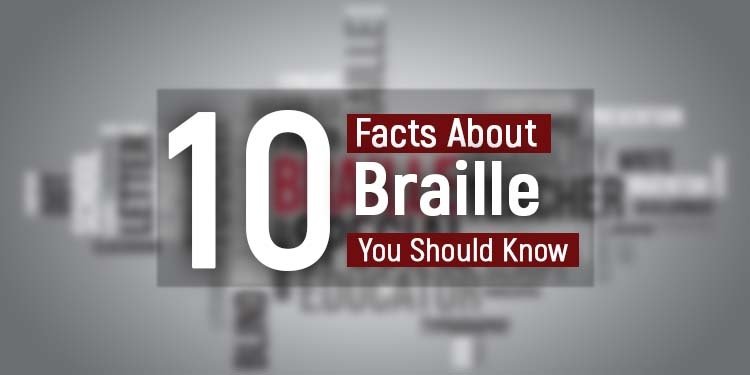Braille is more than just raised dots: it provides lifeline access for millions worldwide who are blind or have low vision. First developed by Louis Braille in 1824, its invention revolutionized how individuals interacted with written text.
In this blog, we will explore the fascinating world of Braille to reveal ten essential facts you should know:
1. Origin of Braille
Louis Braille, an inspirational Frenchman who lost his sight as a youth, created the Braille system in 1824 to assist visually impaired persons struggling with “night writing,” an impractical method compared to Braille’s elegant solution.
2. Naming
“Braille” honors its creator and captures its core purpose—providing tactile language access for blind people who wish to read and write.
3. Universal Code
Contrary to popular belief, Braille isn’t its language – instead, it serves as an umbrella code representing various tongues like English, Spanish, French, and Chinese – making this communication extraordinarily adaptable and flexible.
4. Graded Proficiency
Braille comes in two primary grades. Grade 1 covers alphabet letters and basic punctuation, while grade 2 adds contractions and abbreviations that increase speed and efficiency.
5. Tools of the Trade
From specialist braille writers to stylus and slate, various writing instruments are designed specifically to assist Braille writing that caters to different preferences and needs.
6. Beyond Books
Braille extends far beyond just literature – it can also be used to label products such as medications and food items to ensure accessibility and independence in everyday life.
7. Harmonious Notes
Music lovers rejoice – Braille music notation systems allow blind musicians to read and compose with equal ease as their sighted counterparts!
8. Personal Preferences
While Braille remains invaluable to many with visual impairments, not everyone chooses Braille exclusively; others might opt for audio books or assistive technology instead – underlining the value of tailored accessibility solutions that fit each person individually.
9. Support Networks
Organizations such as the Foundation for Blind Children and Braille Institute have long played an essential role in supporting Braille literacy among blind communities by advocating on their behalf and offering resources. Their unwavering assistance fosters empowerment and inclusion for members of this population.
10. Braille as a Light for Accessibility
Over time, Braille has served as an icon of accessibility by breaking down barriers in education and employment that otherwise prevent individuals with visual impairments from leading fulfilling lives and contributing to society.
Are you curious to gain more insights into Braille and its various applications? Go deeper into tactile literacy with “Braille Music and More,” where you’ll have access to resources, learn new skills, and join an inclusive community dedicated to Braille literacy and accessibility.
FAQs (Frequently Asked Questions)
Q: Is Braille Hard to Learn?
A: As with any language or code, becoming proficient in Braille takes dedication, practice, and resources; with these available, individuals can become masterful Braille readers and open themselves up to literacy and independence.
Q: Can Braille be Used on Electronic Devices?
A: Absolutely. Thanks to advances in technology, Braille displays and Braille-enabled devices have become more widespread, enabling users to access digital content seamlessly.
Q: How Can I Support Braille Literacy Initiatives?
A: You can support Braille literacy efforts in numerous ways, from volunteering for organizations that promote Braille education to advocating for accessible resources within your local community – any effort counts in building an inclusive society!
Q: Are There Braille Resources Available for Children?
A: Various organizations specialize in creating Braille resources tailored specifically towards young learners, including books, games, and educational tools explicitly designed to foster literacy and build their sense of empowerment and independence in young readers. These materials not only promote literacy development in these young minds but can instill confidence through empowerment as well.
Q: Can sighted individuals learn Braille?
A: Absolutely! Learning Braille can develop empathy and understanding among sighted people while equipping them with valuable tools for engaging with blind and visually impaired communities. Many sighted individuals have found tremendous enjoyment and fulfillment from learning Braille.
Final thoughts
Braille isn’t simply raised dots—it’s an avenue towards independence, literacy, and inclusion. With Braille Music and More, join in championing Braille literacy to ensure a more accessible future for everyone. Together, we can harness its power to transform lives!
You Can Also Read Our Other Blogs
- Top 10 Fascinating Facts About Braille
- How to Translate Braille: A Comprehensive Guide
- 4 Ways Learning Braille Can Be Fun and Games
- Braille Alphabet: How Does it Work?
- The Importance of Braille in Today’s World
- The Impact of Braille Menus in Restaurants
- 12 Things You Probably Don’t Know About Braille
- Contracted (Grade 2) Braille Explained
- 12 Things You Probably Don’t Know About Braille
- How to Write in Braille







